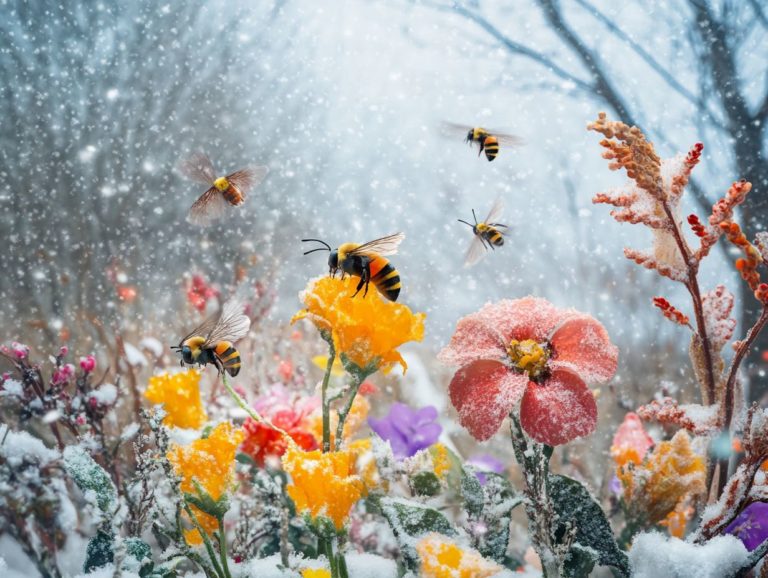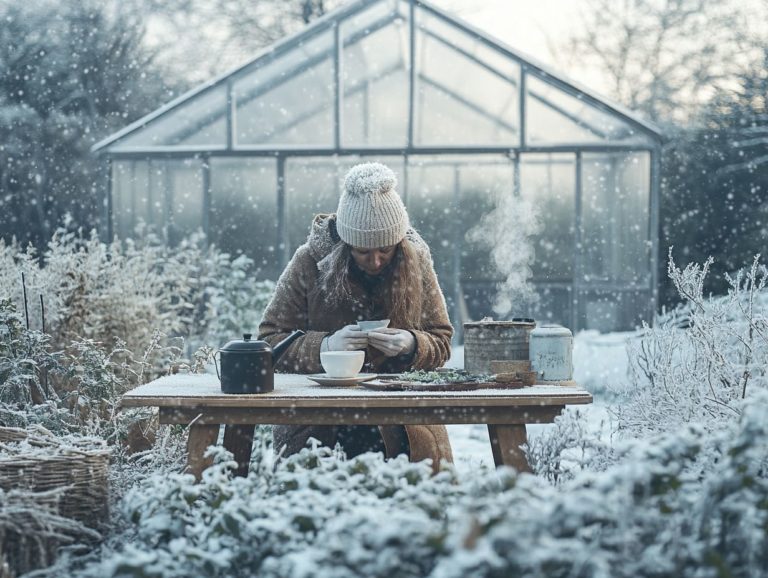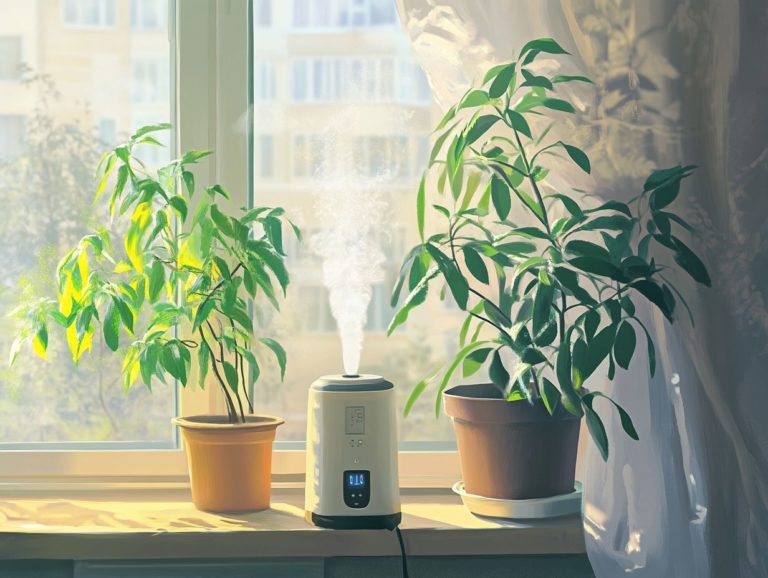How to Grow Winter Flowers Successfully
Winter may appear to be a lull for gardens, yet it presents a remarkable opportunity to cultivate beauty through winter-flowering flowers.
Consider the myriad benefits of nurturing these hardy winter blooms. They enhance your garden’s aesthetics and uplift your spirits during the cold months.
Discover how to choose the ideal varieties, prepare your garden, and provide the essential care these flowers require. You ll also want to address common challenges and gather valuable tips for preserving your winter floral arrangements.
Get ready to dive into the magical world of winter gardening!
Contents
Key Takeaways:

- Winter is not a time for your garden to rest! Brighten your space with winter flowers for environmental and emotional benefits.
- Choose winter flowers that are suitable for your climate, considering factors like sunlight and soil type for successful growth.
- Proper preparation and care, including watering, fertilizing, and protecting from frost, are key to ensuring your winter flowers thrive. Avoid common problems like pests and diseases and preserve your cut flowers for longer enjoyment.
What are Winter Flowers?
Winter flowers stand out as remarkable botanical treasures, growing in colder climates and displaying a delightful array of vibrant colors, even in the chill of frost. Among these gems, hellebores shine brightly. They inject cheerful beauty into otherwise stark landscapes during the winter months.
These resilient plants elevate your garden s aesthetic. They also support local wildlife, including bees and butterflies, making them a vital component of winter gardening in regions like Perth.
In addition to hellebores, explore other resilient varieties like winter jasmine and snowdrops that are equally essential to your winter garden. These flowers showcase colors like soft whites, deep purples, and bright yellows that can brighten any dreary winter day.
Their ability to provide crucial resources for pollinators during the colder months plays a significant role in maintaining ecological balance. By incorporating these native species into your landscaping, you not only enhance visual appeal but also create a welcoming habitat, ensuring your garden remains vibrant and eco-friendly throughout the winter season.
Benefits of Growing Winter Flowers
Growing winter flowers offers a wealth of advantages for both you and the environment, enriching your landscapes while serving as vital resources for winter wildlife. If you’re interested in expanding your garden, consider how to grow a winter salad garden. These vibrant blooms infuse your garden with cheerful colors during the dreary months and provide essential habitats for bees and butterflies, fostering biodiversity.
Winter flowers also help maintain soil and plant health and stabilize the ecosystem, making them an invaluable addition to your gardening endeavors.
Environmental Benefits
The environmental benefits of cultivating winter flowers are truly remarkable. These resilient plants enhance biodiversity and create habitats for various winter wildlife, including essential pollinators like cheerful bees and butterflies. By providing nectar sources during the colder months, winter flowers sustain these vital creatures, crucial for the overall health of the ecosystem.
These hardy blooms are not just pretty faces; they improve soil structure, prevent erosion, and promote water retention. Their presence throughout the winter months supports local wildlife and fosters a symbiotic relationship within the ecosystem, ultimately contributing to a healthier landscape.
As bees and butterflies forage for sustenance, they inadvertently aid in the pollination of other plants once warmer weather arrives, reinforcing the intricate web of life. Therefore, cultivating winter flowers is not merely an act of gardening; it s a strategic step towards nurturing a diverse and vibrant environment.
Start planning your winter garden today and let it shine through the cold months!
Emotional Benefits
Cultivating winter flowers offers more than just beauty. These cheerful blooms can uplift your spirits and improve your mental well-being during cold winter months.
By introducing vibrant colors and unique textures into your garden, winter flowers create a retreat that promotes relaxation and joy. This is especially valuable during a season when daylight hours are short and nature s palette tends to lack vibrancy.
Engaging with these resilient plants gives you a sense of purpose and fosters mindfulness, allowing you to connect deeply with the beauty of nature.
The act of tending to winter flowers can become a grounding ritual. It helps alleviate feelings of seasonal melancholy. Gardening with these colorful winter beauties cultivates an atmosphere of tranquility, providing a cozy, comforting escape that enhances your overall garden experience, even amidst the chill of winter.
Choosing the Right Winter Flowers to Grow
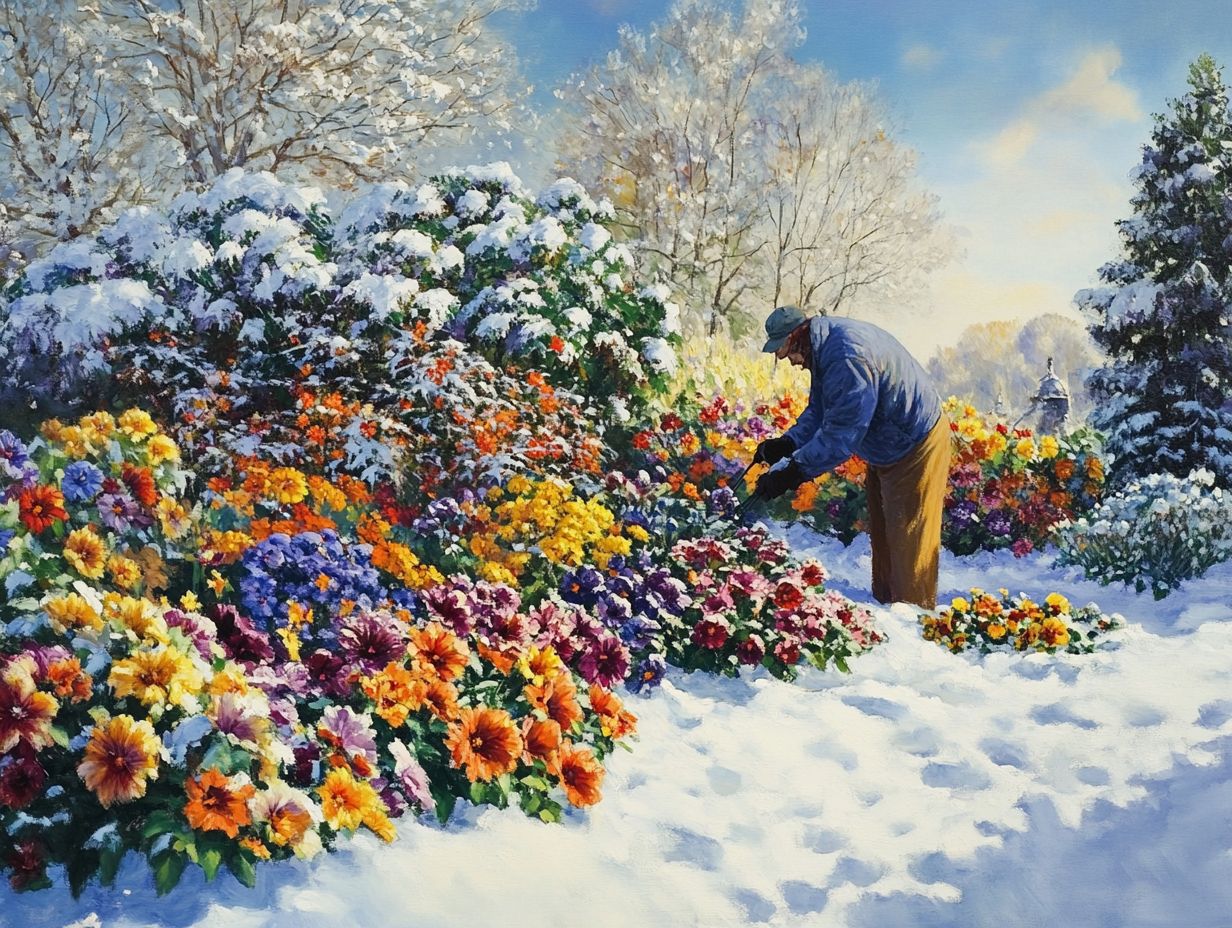
Selecting the perfect winter flowers for your garden demands thoughtful consideration of several key factors. These include your local climate, the overall design of your garden, and the specific colors and varieties that will thrive in your unique environment.
Many discerning gardeners gravitate toward resilient blooms like hellebores and primulas. These hardy choices not only withstand the chill but also infuse delightful bursts of color that contrast strikingly with the starkness of winter.
Factors to Consider
When selecting winter flowers, you must consider several critical factors to ensure they thrive. These factors play a key role in overcoming winter gardening challenges and enhancing your garden’s beauty and ecological balance.
Climate is key; different regions, like Perth, have varying temperatures and soil conditions. It s essential to choose hardy, native plants that can withstand local weather patterns.
Equally important is understanding the soil type. Some flowers flourish in well-drained sandy soils, while others prefer rich, loamy earth. Don’t overlook the compatibility of your chosen flowers with local wildlife. Selecting native varieties can attract beneficial pollinators, nurturing a sustainable ecosystem.
By thoughtfully evaluating these elements, you can create a vibrant winter garden that not only thrives but also enriches the natural habitat. This ultimately contributes to a more resilient environment.
Preparing Your Garden for Winter Flower Growth
Preparing your garden for winter flower growth requires a thoughtful approach, including selecting plants for a winter garden, to optimize soil health. This ensures that winter flowers bloom beautifully in the colder months.
Begin by assessing the quality of your soil; this foundational step is crucial. Next, enhance drainage to prevent waterlogging, which can be detrimental to delicate plants.
Finally, select the right maintenance practices tailored to create a thriving environment for your winter favorites, such as hellebores and primulas. With these techniques in place, you’ll set the stage for a stunning display of color during the winter season.
Preparation Techniques and Tips
To effectively prepare your garden for winter flower growth, consider employing a range of techniques that enhance soil quality and protect your plants.
Techniques such as adding organic matter to the soil, mulching, and adopting proper watering practices can significantly impact how well your winter flowers thrive, just as understanding how to successfully grow garlic in winter can enhance your gardening success.
For instance, incorporating compost or well-rotted manure into the soil can boost its fertility and improve texture. This promotes better drainage and root development.
On the other hand, mulching serves as an insulating layer, helping to regulate soil temperature and suppress weed growth during the colder months. Ensuring your winter flowers receive the right amount of water is crucial.
Overwatering or underwatering can stress them, making them susceptible to diseases. By combining these strategies, you can create an optimal environment for your winter blooms, leading to a more vibrant and resilient garden come springtime.
Caring for Winter Flowers
Winter flowers bring beauty to the frosty landscape, and caring for them can be a delightful adventure! Alongside caring for winter flowers, you can also explore tips for growing microgreens in winter. Caring for winter flowers requires a thoughtful strategy that encompasses proper watering, fertilizing, and safeguarding against frost. All these efforts aim to help them flourish in the chillier months.
Engaging in regular maintenance is key. Monitor soil moisture levels and adjust your care practices based on the ever-changing weather conditions. This will ensure the longevity and vibrancy of your winter garden.
Watering, Fertilizing, and Protecting from Frost
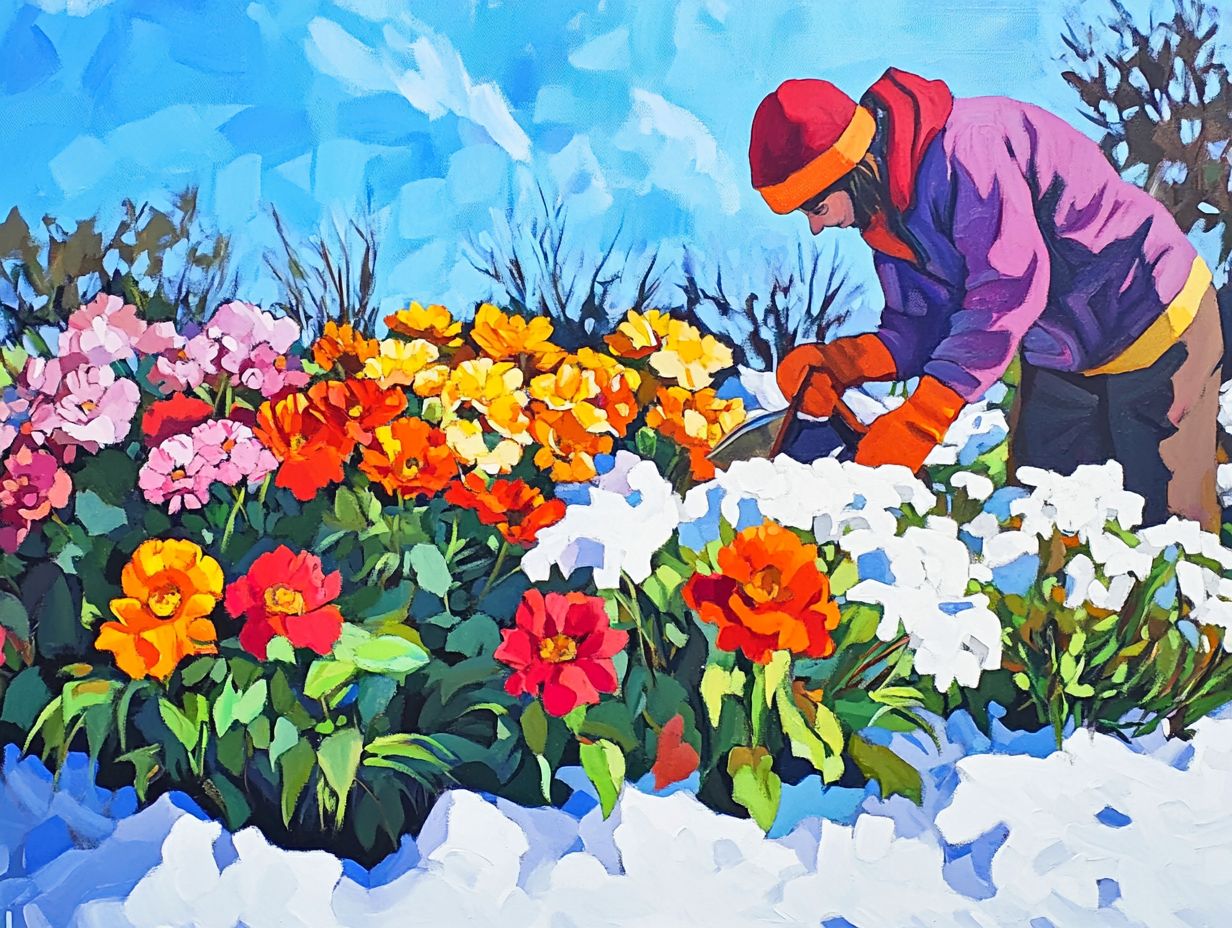
Effective watering, fertilizing, and shielding your winter flowers from frost are essential elements of their care regimen. These factors significantly impact their health and blooming potential. It s crucial to strike a balance between providing adequate moisture and avoiding waterlogged soil. Enrich the plants with fertilizers packed with nutrients to fortify them against the harsh winter conditions.
To ensure optimal hydration, consider watering early in the morning. This allows your plants to absorb moisture before the day warms up. Using a soaker hose a type of hose that delivers water directly to the roots or a drip irrigation system can be particularly effective. These methods prevent oversaturating the foliage.
For fertilization, choose a fertilizer that releases nutrients slowly over time. Protecting your flowers from frost is straightforward. Simply cover them with frost cloths or burlap during particularly chilly nights to create a barrier against biting temperatures. You can also apply mulch around the base of the plants to help retain warmth in the soil.
Common Problems and Solutions
Addressing common challenges and discovering effective solutions is crucial for preserving the health and beauty of winter flowers. These plants can often fall prey to pests and diseases during the colder months. Emphasizing the importance of care during this season will ensure a thriving landscape.
By understanding these obstacles, you can implement management strategies to keep your plants vibrant and resilient throughout the winter.
Pest and Disease Management
Effective pest and disease management is essential for your winter flowers, as these delicate plants are at risk from insects and tough weather. By employing simple pest control methods like using organic pesticides and encouraging beneficial insects like bees and butterflies you can significantly boost the resilience of your blooms.
Maintaining a tidy garden by clearing away dead leaves and debris is a smart move to prevent pests and pathogens from taking hold. Don t wait! Inspect your plants regularly to catch problems early, such as aphids, spider mites, or fungal infections. These issues can escalate quickly if you let them slip by.
Incorporating crop rotation and selecting disease-resistant flower varieties will further enhance the health of your plants. Don’t overlook the importance of regular soil amendments and proper watering practices. These foundational steps, along with tips for sustainable winter gardening, will help maintain soil health and ensure your winter-flowering flowers receive the nutrients they need to thrive, even in challenging seasonal conditions.
Harvesting and Preserving Winter Flowers
Harvesting and preserving winter flowers is an art form that allows you to enjoy the exquisite beauty of these blooms well beyond the growing season. Selecting cheerful arrangements will enhance the aesthetic appeal of your indoor spaces.
By employing precise techniques for cutting and storing flowers such as primulas and pansies, you can craft stunning arrangements that infuse your indoor spaces with vibrant colors. Incorporating other varieties like violas and kale can enhance your creations.
Tips for Prolonging the Lifespan of Cut Flowers
You can extend the lifespan of cut flowers from your winter garden. Use simple tips and techniques to keep them fresh and vibrant in your arrangements.
Start by ensuring that your vases are thoroughly cleaned before use. This step is crucial in preventing bacterial growth, which can shorten the life of those delicate blooms.
Trimming the stems at an angle increases the surface area for water absorption. This allows your flowers to drink up more effectively.
Remove any leaves that will be submerged underwater to minimize decay. If possible, place the flowers in a refrigerator for a few hours to mimic a cooler climate, which can further preserve their beauty.
Using floral preservatives provides essential nutrients that help maintain vibrant colors and overall health. This allows your arrangements to shine even longer!
Frequently Asked Questions

What are some key tips for successfully growing winter flowers?
Choosing the right plants can make your garden shine! Provide proper care and protect them from harsh winter conditions. Select cold-hardy flowers, and ensure adequate watering, sunlight, and insulation to help them survive the colder months.
What are some popular winter flowers to consider growing?
Popular winter flowers include pansies, snapdragons, flowering kale, cyclamen, and hellebores. These cold-tolerant plants add a splash of color to your winter garden.
How can I protect my winter flowers from frost?
To protect your winter flowers from frost, cover them with a frost cloth or mulch to insulate them and retain heat. You can also bring potted plants indoors or move them to a sheltered area to protect them from freezing temperatures.
Can I grow winter flowers in a container garden?
Yes, you can grow winter flowers in a container garden! Choose cold-hardy plants, use well-draining soil, and provide adequate insulation. To learn more about effective methods, consider checking out how to start your winter gardening early. Additionally, consider using containers with built-in insulation or adding mulch around the base of the plants to keep the roots warm.
How often should winter flowers be watered?
Water winter flowers regularly, but not as frequently as during warmer months. Monitor the soil moisture and only water when the top inch of soil is dry. Overwatering can lead to root rot, so be careful not to water too much.
Do I need to fertilize my winter flowers?
It is not necessary to fertilize winter flowers as they are in their dormant phase during winter. However, if you choose to fertilize, use a slow-release fertilizer in the fall to provide nutrients throughout the winter. Avoid fertilizing during the winter to prevent stimulating new growth, which is susceptible to frost damage.
Start implementing these tips today to see immediate improvements in the health and longevity of your cut flowers!

